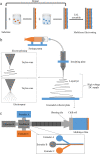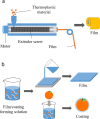A review of multilayer and composite films and coatings for active biodegradable packaging
- PMID: 35277514
- PMCID: PMC8917176
- DOI: 10.1038/s41538-022-00132-8
A review of multilayer and composite films and coatings for active biodegradable packaging
Abstract
Active biodegradable packaging are being developed from biodegradable biopolymers which may solve the environmental problems caused by petroleum-based materials (plastics), as well as improving the shelf life, quality, nutritional profile, and safety of packaged food. The functional performance of active ingredients in biodegradable packaging can be extended by controlling their release profiles. This can be achieved by incorporating active ingredients in sandwich-structured packaging including multilayer and composite packaging. In multilayer materials, the release profile can be controlled by altering the type, structure, and thickness of the different layers. In composite materials, the release profile can be manipulated by altering the interactions of active ingredients with the surrounding biopolymer matrix. This article reviews the preparation, properties, and applications of multilayer and composite packaging for controlling the release of active ingredients. Besides, the basic theory of controlled release is also elaborated, including diffusion, swelling, and biodegradation. Mathematical models are presented to describe and predict the controlled release of active ingredients from thin films, which may help researchers design packaging materials with improved functional performance.
© 2022. The Author(s).
Conflict of interest statement
The authors declare no competing interests.
Figures





Similar articles
-
Biopolymer-based functional films for packaging applications: A review.Front Nutr. 2022 Aug 22;9:1000116. doi: 10.3389/fnut.2022.1000116. eCollection 2022. Front Nutr. 2022. PMID: 36071940 Free PMC article. Review.
-
A Comprehensive Review of Biodegradable Polymer-Based Films and Coatings and Their Food Packaging Applications.Materials (Basel). 2022 Aug 26;15(17):5899. doi: 10.3390/ma15175899. Materials (Basel). 2022. PMID: 36079280 Free PMC article. Review.
-
Recent Progress of Carrageenan-Based Composite Films in Active and Intelligent Food Packaging Applications.Polymers (Basel). 2024 Apr 6;16(7):1001. doi: 10.3390/polym16071001. Polymers (Basel). 2024. PMID: 38611259 Free PMC article. Review.
-
Application of Nanotechnology to Improve the Performance of Biodegradable Biopolymer-Based Packaging Materials.Polymers (Basel). 2021 Dec 15;13(24):4399. doi: 10.3390/polym13244399. Polymers (Basel). 2021. PMID: 34960949 Free PMC article. Review.
-
Natural biopolymer-based nanocomposite films for packaging applications.Crit Rev Food Sci Nutr. 2007;47(4):411-33. doi: 10.1080/10408390600846366. Crit Rev Food Sci Nutr. 2007. PMID: 17457725 Review.
Cited by
-
Active Starch-Polyester Bilayer Films with Surface-Incorporated Ferulic Acid.Membranes (Basel). 2022 Oct 6;12(10):976. doi: 10.3390/membranes12100976. Membranes (Basel). 2022. PMID: 36295734 Free PMC article.
-
Silver/bacterial cellulose/Clitoria ternatea composite film for packaging application: synthesis, characterization and antibacterial properties.3 Biotech. 2025 May;15(5):113. doi: 10.1007/s13205-025-04284-8. Epub 2025 Apr 3. 3 Biotech. 2025. PMID: 40191456
-
Sustainable and Bio-Based Food Packaging: A Review on Past and Current Design Innovations.Foods. 2023 Mar 2;12(5):1057. doi: 10.3390/foods12051057. Foods. 2023. PMID: 36900574 Free PMC article. Review.
-
Fish oil-containing edible films with active film incorporated with extract of Psidium guajava leaves: preparation and characterization of double-layered edible film.F1000Res. 2024 Oct 30;13:816. doi: 10.12688/f1000research.153383.2. eCollection 2024. F1000Res. 2024. PMID: 39526117 Free PMC article.
-
Exploring the Potential of Chitosan-Phytochemical Composites in Preventing the Contamination of Antibiotic-Resistant Bacteria on Food Surfaces: A Review.Molecules. 2025 Jan 21;30(3):455. doi: 10.3390/molecules30030455. Molecules. 2025. PMID: 39942558 Free PMC article. Review.
References
-
- Debeaufort F, Voilley J-AQ-GA. Edible films and coatings: tomorrow’s packagings: a review. Food Sci. Nutr. 2010;38:299–313. - PubMed
-
- Barbosa CH, Andrade MA, Vilarinho F, Fernando AL, Silva AS. Active edible packaging. Encyclopedia. 2021;1:360–370.
-
- Ribeiro AM, Estevinho BN, Rocha F. Preparation and incorporation of functional ingredients in edible films and coatings. Food Bioprocess Technol. 2021;14:209–231.
Publication types
LinkOut - more resources
Full Text Sources
Other Literature Sources

